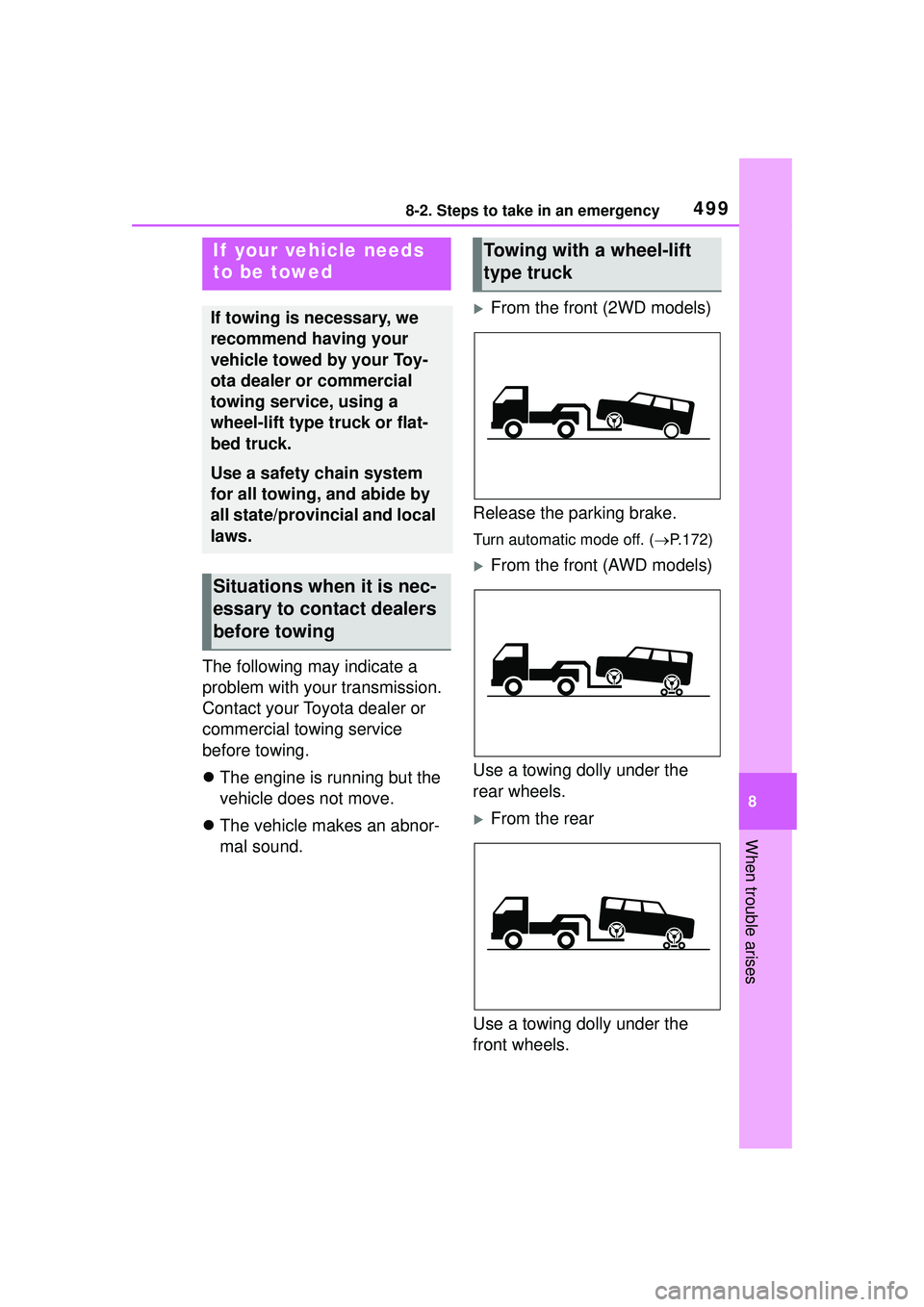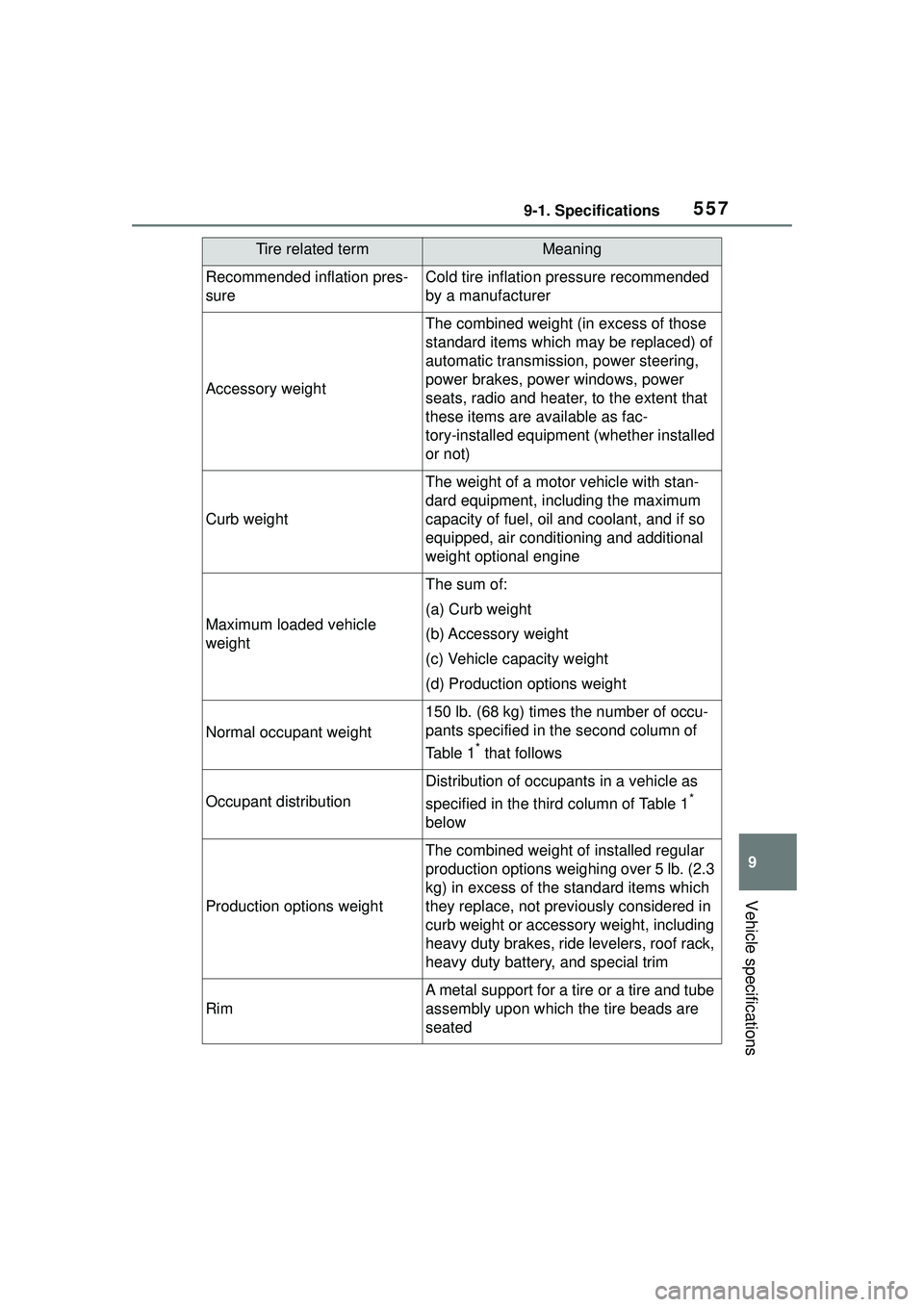2022 TOYOTA COROLLA CROSS automatic transmission
[x] Cancel search: automatic transmissionPage 170 of 612

1704-2. Driving procedures
The selected gear step, from M1 to
M10, will be displayed on the
multi-information display.
However, even when in the M
position, the gear steps will be
automatically changed if the
engine speed is too high, or too
low.
■Gear step functions
●You can choose from 10 levels of
engine braking force.
●A lower gear step will provide
greater engine braking force than
a higher gear step, and the engine
speed will also increase.
■When the vehicle comes to a
stop with the shift lever in the M
position
●The transmission will automati-
cally downshift to M1 once the
vehicle is stopped.
●After a stop, the vehicle will start
off in M1.
●When the vehicle is stopped, the
transmission is set at M1.
■Downshifting restriction warn-
ing buzzer
To help ensure safety and driving
performance, downshifting opera-
tion may sometimes be restricted. In
some circumstances, downshifting
may not be possible even when the
shift lever is oper ated. (A buzzer will
sound twice.)
■If the 10-speed sport sequential
shiftmatic mode indicator does
not come on even after shifting
the shift lever to M
This may indicate a malfunction in
the continuously variable transmis-
sion system. Have the vehicle
inspected by your Toyota dealer
immediately.
(In this situation, the transmission
will operate in the same manner as
when the shift lever is in D.)
1 Right turn
2 Lane change to the right
(move the lever partway and
release it)
The right hand signals will flash 3
times.
3Lane change to the left
(move the lever partway and
release it)
The left hand signals will flash 3
times.
4Left turn
■Turn signals can be operated
when
The engine switch is in ON.
■If the indicator flashes faster
than usual
Check that a light bulb in the front or
rear turn signal lights has not
Tur n signal lever
Operating instructions
Page 229 of 612

2294-5. Using the driving support systems
4
Driving
■Operating conditions
●The Stop & Start system is opera-
tional when all of the following
conditions are met:
• The vehicle has been driven a cer-
tain amount of time.
• The brake pedal is being depressed firmly. (Except when
the vehicle is stopped by the
dynamic radar cruise control with
full-speed range when in vehi-
cle-to-vehicle distance control
mode)
• The D or P shift position is
selected.
• The driver’s seat belt is fastened.
• The driver’s door is closed.
• The windshield defogger is off. (vehicles without a manual air
conditioning system)
• The accelerator pedal is not being depressed.
• The engine is adequately warmed
up.
• The outside temperature is 23°F (-5°C ) or higher.
• The hood is closed. ( P.230)
●In the following situations the
engine may not be stopped by the
Stop & Start system. This is not a
malfunction of the Stop & Start
system.
• When the air conditioning system is being used.
• When the battery is undergoing a periodic recharge.
• When the battery is not sufficiently
charged, such as if the vehicle
has been parked for a long time
and the battery charge has
decreased, the electric load is
large, the battery fluid tempera-
ture is excessively low or the bat-
tery has deteriorated.
• When the brake booster vacuum is low.
• When the elapsed time since the
engine was restarted is short.
• When the vehicle is stopped fre- quently, such as when in a traffic
jam.
• When the engine coolant tem- perature or transmission fluid tem- perature is extremely low or high.
• When the vehicle is stopped on a steep incline.
• When the vehicle is being driven in a high altitude area.
• When the battery fluid tempera-
ture is extremely low or high.
• For a while after the battery termi- nals have been disconnected and
reconnected.
●When the engine is stopped by
the Stop & Start system, the
engine will be restarted automati-
cally if any of the following condi-
tions are met: (To enable the
engine to be stopped by the Stop
& Start system again, drive the
vehicle.)
• The air conditioning system is turned on. (vehicles without a
manual air conditioning system)
• The windshield defogger is turned on. (vehicles without a manual air
conditioning system)
• The shift lever is shifted from D or P.
• The shift lever is shifted from P. (When the engine is stopped by
the Stop & Start system when the
shift lever is in P.)
• The driver’s seat belt is unfas- tened.
• The driver’s door is opened.
• The Stop & Start cancel switch is
pressed.
• The accelerator pedal is depressed.
• The vehicle starts to roll on an
incline.
●When the engine is stopped by
the Stop & Start system, the
engine may restart automatically
in the following situations: (To
enable the engine to be stopped
by the Stop & Start system again,
drive the vehicle.)
• When the brake pedal is pumped
or strongly depressed.
• When the air conditioning system is being used.
• When a switch of the air condition- ing system is operated (windshield
defogger switch, etc.).
Page 499 of 612

4998-2. Steps to take in an emergency
8
When trouble arises
8-2.Steps to take in an emergency
The following may indicate a
problem with your transmission.
Contact your Toyota dealer or
commercial towing service
before towing.
The engine is running but the
vehicle does not move.
The vehicle makes an abnor-
mal sound.
From the front (2WD models)
Release the parking brake.
Turn automatic mode off. ( P.172)
From the front (AWD models)
Use a towing dolly under the
rear wheels.
From the rear
Use a towing dolly under the
front wheels.
If your vehicle needs
to be towed
If towing is necessary, we
recommend having your
vehicle towed by your Toy-
ota dealer or commercial
towing service, using a
wheel-lift type truck or flat-
bed truck.
Use a safety chain system
for all towing, and abide by
all state/provincial and local
laws.
Situations when it is nec-
essary to contact dealers
before towing
Towing with a wheel-lift
type truck
Page 557 of 612

5579-1. Specifications
9
Vehicle specifications
Recommended inflation pres-
sureCold tire inflation pressure recommended
by a manufacturer
Accessory weight
The combined weight (in excess of those
standard items which may be replaced) of
automatic transmission, power steering,
power brakes, power windows, power
seats, radio and heater, to the extent that
these items are available as fac-
tory-installed equipment (whether installed
or not)
Curb weight
The weight of a motor vehicle with stan-
dard equipment, including the maximum
capacity of fuel, oil and coolant, and if so
equipped, air conditioning and additional
weight optional engine
Maximum loaded vehicle
weight
The sum of:
(a) Curb weight
(b) Accessory weight
(c) Vehicle capacity weight
(d) Production options weight
Normal occupant weight
150 lb. (68 kg) times the number of occu-
pants specified in the second column of
Table 1
* that follows
Occupant distribution
Distribution of occupants in a vehicle as
specified in the third column of Table 1
*
below
Production options weight
The combined weight of installed regular
production options weighing over 5 lb. (2.3
kg) in excess of the standard items which
they replace, not previously considered in
curb weight or accessory weight, including
heavy duty brakes, ride levelers, roof rack,
heavy duty battery, and special trim
Rim
A metal support for a tire or a tire and tube
assembly upon which the tire beads are
seated
Tire related termMeaning
Page 599 of 612

599Alphabetical Index
If you have a flat tire ............. 518
Inflation pressure.................. 478
Information ........................... 552
Replacing ............................. 518
Rotating tires ........................ 470
Size ...................................... 548
Snow tires ............................ 274
Spare tire.............................. 518
Tire pressure warning system........................................... 470
Warning light ........................ 509
Tools ........................................ 519
Top tether strap ........................ 64
Total load capacity ................. 542
Touch screen .......................... 288 Touch screen gestures ......... 288
Touch screen operation ........ 288
To w i n g Dinghy towing....................... 161
Emergency towing................ 499
Towing eyelet ....................... 501
Trailer towing ........................ 151
Toyota apps ............................ 403
Toyota apps Entering keyword ................. 405
Toyota apps button (Setup screen) .................................. 286
Toyota apps settings.............. 407
Toyota Safety Sense 2.0 Automatic High Beam .......... 180
Dynamic radar cruise control with full-speed range .......... 216
LTA (Lane Tracing Assist) ..... 203
PCS (Pre-Collision System) . 195
RSA (Road Sign Assist) ....... 213
TRAC (Traction Control) ........ 269
Traction Control (TRAC) ........ 269
Trailer towing .......................... 151
Transmission Continuously variable transmis-sion..................................... 167 If the shift lever cannot be shifted
from P .................................168
M mode ................................169
Trip meters ..........................82, 87
Turn signal lights Replacing light bulbs ............489
Turn signal lever ...................170
Wattage ................................549
U
USB charging port ..................433
USB memory ...........................337
USB port ..................................328
V
Vanity lights ............................442Wattage ................................549
Vanity mirrors .........................442
Vehicle button (Setup screen) .......................................286, 324
Vehicle data reco rding ...............8
Vehicle identification number543
Vehicle information display .....94
Vehicle settings ......................324 Displaying the vehicle settings screen.................................324
Valet mode setting ................324
Vehicle settings screen.........324
Vehicle Stability Control (VSC) ...............................................269
Voice button (Setup screen) 286, 323
Voice command sy stem .........358
Using the voice command sys- tem .....................................358
Voice command system opera- tion......................................359
Voice settings .........................323 Displaying the voice settings screen.................................323
Voice settings screen ...........323